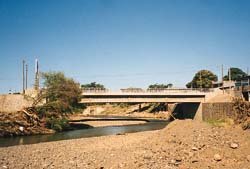Official Development Assistance (ODA)
7. Japanese Bridges Survive Nicaraguan Hurricane Unscathed
From late October 1998, Hurricane Mitch, the fourth largest hurricane in meteorological history, struck Central America, leaving a trail of devastation in the region. Amid media reports of the shocking amount of damage caused by the hurricane, attention was drawn to bridges constructed through Japanese grant aid, which had survived the disaster unscathed.
In Nicaragua, the Pan-American Highway serves as the country's lifeline in terms of transport and distribution, linking the country to neighboring Honduras and Costa Rica. Japan has built seven bridges along the Nicaraguan stretch of the highway, all of which remained unharmed even as the enormous force of the hurricane swept away other bridges nationwide.
President Arnoldo Aleman invited Japanese Ambassador Masaru Ito to join him on an inspection of hurricane damage. In Matagalpa, the area hardest hit by the hurricane, they discovered that two bridges built with Japanese collaboration were still intact. The president praised Japanese technology and the dedication of Japan's engineers. He admired the great technical skills of the Japanese engineers who had built these bridges, standing proud and fast where bridges everywhere else were lying in ruins, and promised to report this achievement to the Japanese people with the gratitude of the people of Nicaragua. His comments having been made in the presence of the reporters, articles on the Japanese bridges subsequently appeared in the local media, including a La Prensa de Nicaragua article entitled "A Responsible Industrialized Country", demonstrating great confidence in and expectations of Japanese cooperation.

Sebaco Bridge, one of the Nicaraguan bridges surviving Hurricane Mitch

Sebaco Bridge, one of the Nicaraguan bridges surviving Hurricane Mitch
